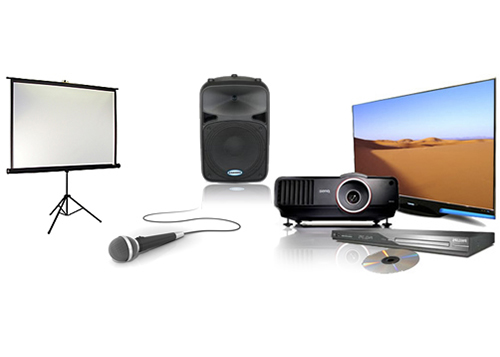How audio visual charlotte nc supports marketing messages
Understanding the Inclusion of Audio Visual Innovation in Today's Educational Environments
The combination of audio-visual innovation in academic settings has changed the mentor and learning procedure. Educators currently have access to tools that satisfy various learning designs, enhancing trainee involvement and cooperation. Nevertheless, the incorporation of these innovations provides both opportunities and challenges. Understanding exactly how to successfully apply these devices is necessary. What techniques can instructors employ to make the most of the benefits of audio-visual modern technology in their classrooms?
The Evolution of Audio-Visual Innovation in Education And Learning
As educational needs advanced over the years, audio-visual modern technology undertook considerable makeovers that improved the understanding atmosphere. Tools such as film projectors and slide shows were the key means of incorporating aesthetic components right into classrooms. These very early technologies given teachers with the capability to present information dynamically, yet they were restricted in access and interactivity.
With the arrival of videotape recorder in the 1970s, classrooms began to incorporate recorded lessons, expanding the range of educational sources. The introduction of computers in the 1980s further revolutionized this landscape, enabling the development of multimedia presentations and interactive knowing experiences.
The rise of the internet in the 1990s noted a turning point, making it possible for real-time accessibility to a wealth of audio-visual materials. Today, digital tools such as interactive white boards and online understanding systems continue to enhance the educational experience, fostering involvement and partnership among students.
Advantages of Audio-Visual Devices for Diverse Discovering Styles
Audio-visual devices play a crucial function in accommodating varied discovering styles by enhancing aesthetic learning and enhancing acoustic interaction. By including images, videos, and sound, these modern technologies create a more comprehensive academic environment. This multifaceted approach permits teachers to deal with the different preferences and needs of trainees successfully.
Enhancing Visual Learning
Involvement in the learning procedure is markedly boosted via the usage of audio-visual tools, catering to different learning designs. These devices, such as video clips, infographics, and interactive discussions, give aesthetic stimulations that help comprehension and retention. Aesthetic students, specifically, take advantage of the incorporation of pictures and computer animations, which can streamline complex concepts and boost understanding. Additionally, audio-visual sources can highlight real-world applications, making finding out more relevant and engaging. By integrating color, movement, and noise, instructors can develop a dynamic understanding environment that records students' focus and promotes much deeper cognitive links. Eventually, the calculated usage of audio-visual modern technology not just supports visual understanding yet additionally enhances the overall educational experience for varied learners.
Improving Auditory Involvement
A substantial advantage of incorporating audio-visual tools in education and learning is their capacity to enhance acoustic engagement amongst pupils. These tools, which encompass multimedia presentations, podcasts, and interactive sound aspects, accommodate numerous learning designs, particularly benefiting acoustic learners (audio visual charlotte nc). By incorporating audio and narrative, educators can create immersive experiences that catch trainees' attention and strengthen comprehension. This interaction is essential, as it fosters a deeper understanding of the product and promotes retention. Additionally, audio-visual tools can facilitate collective knowing environments, encouraging students to participate in discussions and share their understandings. Inevitably, the consolidation of audio-visual innovation not just supports auditory interaction but also enhances the overall educational experience, making discovering more vibrant and reliable for all students
Enhancing Engagement Through Interactive Discovering

Gamification elements, such as tests and simulations, can improve inspiration and retention, making finding out extra enjoyable and effective. These methods not just promote cognitive involvement yet also deal with diverse learning styles, making sure that all trainees can get involved meaningfully. As an outcome, interactive understanding settings cultivate a feeling of area and belonging, inevitably bring about boosted scholastic end results. Through the assimilation of audio aesthetic modern technology, instructors can change traditional class right into vivid rooms where trainees prosper and proactively form their academic journeys.
Bridging Concept and Exercise With Multimedia Resources
Multimedia resources function as a critical web link between theoretical principles and functional application in academic settings. By enhancing involvement, promoting joint discovering experiences, and sustaining varied discovering styles, these devices produce a more comprehensive and dynamic learning setting - audio visual charlotte nc. This technique not only cultivates deeper understanding yet likewise prepares students for real-world obstacles

Enhancing Engagement Via Multimedia
Engagement in instructional settings substantially enhances when teachers incorporate multimedia check over here sources into their training methods. The usage of video clips, podcasts, and interactive discussions enhances the learning experience, enabling pupils to attach with the product on numerous levels. Multimedia sources satisfy various discovering designs, supplying aesthetic, auditory, and kinesthetic stimuli that can hold trainees' focus more effectively than standard lecture approaches. Additionally, these resources can simplify complicated concepts, making them a lot more accessible and memorable. By integrating multimedia, teachers can produce a vibrant classroom environment that promotes interest and encourages students. Inevitably, the calculated use audio-visual modern technology offers to bridge the gap between academic expertise and sensible application, enriching the educational experience for both instructors and students.
Facilitating Collaborative Discovering Experiences
Countless research studies suggest that collective learning experiences significantly improve student results when integrated with multimedia resources. Multimedia tools help with communication among students, allowing them to involve in analytic and essential assuming jointly. By using video conferencing, collaborative systems, and interactive discussions, teachers create atmospheres favorable to teamwork and shared learning. These modern technologies make it possible for trainees to communicate their ideas efficiently and receive prompt comments, fostering a much deeper understanding of the subject. Additionally, multimedia sources can present intricate ideas in even more digestible try this web-site layouts, advertising discussion and partnership. Therefore, the mix of collaborative understanding and audio-visual technology not just enhances the instructional experience however additionally prepares trainees for real-world team effort dynamics, stressing the significance of participation and collective expertise construction.
Supporting Diverse Understanding Styles
While conventional training techniques often accommodate a minimal variety of learning preferences, the assimilation of audio-visual technology provides an extra inclusive method to education and learning. By utilizing multimedia sources such as video clips, interactive simulations, and digital discussions, teachers can attend to various learning designs, consisting of aesthetic, auditory, and kinesthetic. This versatility permits differentiated instruction, allowing pupils to engage with content in methods that resonate with their private choices. Furthermore, audio-visual devices can promote much deeper understanding by providing multiple representations of complex concepts. Consequently, students who may have problem with conventional approaches can find alternative pathways to success, fostering a more fair learning setting that sustains scholastic success for all students.
Difficulties in Carrying Out Audio-Visual Innovation
Audio-visual innovation holds terrific guarantee for enhancing instructional experiences, its application frequently encounters substantial difficulties. One primary concern is the economic burden related to investing in and preserving such equipment, which can stress budget plans, specifically in underfunded organizations. Additionally, poor training for teachers can prevent efficient assimilation, leaving them ill-prepared to use the modern technology completely. Technical issues, such as software application malfunctions and compatibility issues, might likewise interrupt lessons and annoy both educators and students. Additionally, varying levels of pupil accessibility to technology outside the class can create variations in finding out opportunities. The potential for over-reliance on innovation might take away from essential mentor techniques, eventually restricting the instructional experience. Addressing these difficulties needs a comprehensive method, including appropriate financing, expert growth, and fair access to sources, to ensure that audio-visual modern technology can be leveraged properly in today's instructional settings.
Ideal Practices for Integrating Modern Technology in the Classroom

Additionally, promoting an interactive setting via collaborative tools urges student interaction and involvement. Making use of varied audio-visual sources accommodates various discovering designs, suiting aesthetic, acoustic, and kinesthetic learners. Frequently evaluating the effect of innovation on pupil understanding helps educators refine their methods and adjust to transforming demands. Including students in the selection of technology promotes ownership and motivation. By adhering to these finest methods, educators can create a vibrant classroom environment that successfully incorporates modern technology and enhances the academic experience for all students.
The Future of Audio-Visual Technology in Education
As class significantly accept technology, the landscape of audio-visual devices in education and learning remains to advance (audio visual charlotte nc). Future improvements are expected to focus on better interactivity and customization, enabling educators to customize finding out experiences to private student demands. Technologies such as enhanced reality (AR) and digital reality (VIRTUAL REALITY) will likely provide immersive understanding atmospheres, enhancing pupil engagement and understanding
Fabricated intelligence (AI) is positioned to play a significant function in audio-visual innovation by offering real-time comments and flexible learning pathways. This assimilation may assist educators determine and resolve student difficulties better. Cloud-based systems will certainly help with less complicated access to resources and partnership amongst students and instructors, despite area.
In enhancement to these technological breakthroughs, professional development for teachers will certainly be essential, ensuring they are furnished to make use of these devices effectively. In general, the future of audio-visual innovation in education and learning assures to create more dynamic, inclusive, and impactful knowing experiences.
Often Asked Inquiries
How Can Teachers Choose the Right Audio-Visual Equipment for Their Classrooms?
Choosing proper audio-visual tools needs instructors to examine their instructional objectives, think about trainee requirements, review readily available technology, and seek suggestions from peers or professionals, making sure devices successfully enhance learning and engagement within their particular classroom atmosphere.
What Budget plan Factors to consider Are There for Executing Audio-Visual Innovation?
Budget factors to consider for applying audio-visual technology consist of preliminary purchase costs, upkeep costs, training for staff, and prospective software program licensing charges. Additionally, lasting investment in updates and replacements need to likewise be factored into economic preparation.
Are There Details Training Resources for Teachers on Audio-Visual Tools?
Numerous institutions offer training sources for instructors on audio-visual devices, consisting of online courses, workshops, and instructional overviews. These resources intend to improve teachers' skills and confidence in efficiently incorporating technology into their training methods.
Just how Do We Measure the Performance of Audio-Visual Innovation in Learning?
Determining the performance of audio-visual innovation in learning includes evaluating pupil interaction, understanding, retention rates, and general scholastic performance. Surveys, assessments, and observational researches can offer useful understandings into its effect on instructional outcomes.
What Prevail Mistaken Beliefs Concerning Audio-Visual Modern Technology in Education?
Typical false impressions concerning audio-visual technology in education include the belief that it ensures involvement and learning end results, in addition to the presumption that all students benefit similarly, forgeting private learning choices and needs.